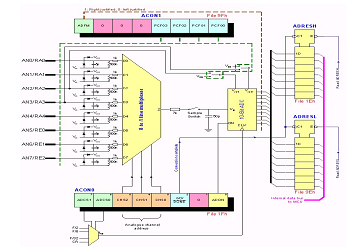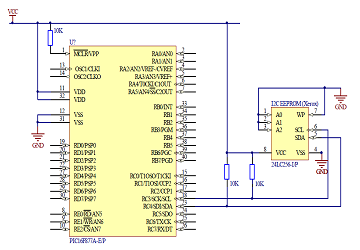
Microchip PIC16F628A Diagram
Inputs and Outputs diagram
This subject demonstrates the utility of microcontrollers, focusing in:

Assembly language is the most basic form of programming in the microcontroller, where communication is sent through bits to the hardware. The following programs were developed in Assembly language and performed on a Microchip PIC16F877:

Using a different compiler ("MPLab XC8" in this case), it is possible to program in "C" language instead of "Assembly". It is more practical and provides extra functionality, enabling the development of the following programs (Microchip PIC16F877):

In this section there is a set of pictures showcasing some of the diagrams/schematics for the programs.

Inputs and Outputs diagram

A very simple code sample written in Assembly language.

In the design environment it is possible to simulate the control system.

An assembly code would be compiled to a microcontroller in order to control the water levels of the tank.

In order to read temperature value, an analog channel needs to be setup on the microcontroller, generating a 10 bit binary number upon converting it to a digital signal.

A schematic of the electrical connections necessary to control a stepper motor using a microcontroller.

A schematic of the electrical connections necessary to control a DC motor using a microcontroller.

A schematic of the electrical connections necessary to establish communication using Rs232 protocol.

A schematic of the electrical connections necessary to establish communication between microcontroller and EEPROM memory using SPI protocol.

A schematic of the electrical connections necessary to establish communication between microcontroller and EEPROM memory using I2C protocol.
This subject provided tools to control and activate many different systems using a very powerful yet small device. It proved that anyone with electrical and programming competencies can control such systems using microcontrollers. It has also provided important knowledge concerning communication protocols and how data flows in the studied electronic circuits.
Code for microcontroller programs
Setting up circuits controlled by a microcontroller.